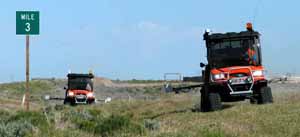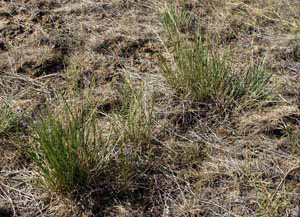
| CONNECTIONS |
IDAHO
ITD
HOME
511 TRAVEL SERVICES
IDAHO
DMV
ITD
NEWS
HIGHWAY
SAFETY
IDAHO STATE POLICE
STATE OF IDAHO
NIATT
NATIONAL
AASHTO
AAMVA
AAA of IDAHO
FEDERAL HIGHWAYS
FEDERAL AVIATION
IDAHO STATE POLICE
NHTSA
NTSB
TRB
U.S. DOT
TRANSPORTER
Archives
Milestones
Comments
Idaho
Transportation
Department
Office of Communications
P.O. Box 7129
Boise, ID 83707
208.334.8005
Fax: 208.334.8563


ITD, BLM wage roadside war on weeds
Cheatgrass is a common sight for travelers along just about any highway throughout the West, and Idaho is no exception. The aggressive oat-like grass, or brome, challenges Idaho Transportation Department road maintenance crews each year to check its relentless spread along the state’s roadways.
This year, ITD, the Bureau of Land Management and United Agriproducts pooled resources in a pilot project along a section of Interstate 84 that is designed to control the yearly carpet of cheatgrass as well as other noxious weeds or aggressive weedy species like kosha, tumble mustard, Russian thistle, bur buttercup and rush skeleton weed.
The
invader weeds are not only unsightly, but regularly fuel roadside wildfires
that cause  hazardous
driving conditions as well as promoting undesirable and unmanageable
vegetation along roadsides, according to Cathy Ford, ITD roadside program
administrator.
hazardous
driving conditions as well as promoting undesirable and unmanageable
vegetation along roadsides, according to Cathy Ford, ITD roadside program
administrator.
Traditionally, ITD road maintenance crews attacked the weed problem by simply keeping roadsides and medians mowed and treating the shoulders with selective herbicides. At best it is a temporary fix.
“Mowing doesn’t really get rid of cheatgrass,” Ford said, adding that seed produced from the plant can germinate multiple times within a growing season and flourishes in Idaho’s high desert climate. It is a winter annual that traditionally germinates in the fall and again in late winter/early spring.
United Agriproducts started treating a 20-mile stretch of I-84 east of Boise with herbicide applications in February and continues to monitor vegetative growth within this section, Ford said. Re-seeding efforts will begin in September.
“Our goal for the project is to reduce the cheatgrass enough so we can start establishing a perennial vegetation layer,” she said. “When we establish more perennial vegetation the fire frequencies are reduced.”
 BLM
fire crews spend a lot of time each summer putting cheatgrass-fed fires
out along the corridor between Boise and Mountain Home. “Our engine
crews are coming out here quite a bit,” said Irene Saphra, a field
specialist for BLM.
BLM
fire crews spend a lot of time each summer putting cheatgrass-fed fires
out along the corridor between Boise and Mountain Home. “Our engine
crews are coming out here quite a bit,” said Irene Saphra, a field
specialist for BLM.
“Realizing that we have that problem, we thought that if we could work together with ITD and come up with some kind of agreement to try to treat the fuels along Interstate 84 and reduce the fire tolerant vegetation, that would slow fire spread and hopefully reduce the amount of time that we spend out there,” Saphra explained.
Greg Cox manages the project for United Agriproducts and said he finds the roadside cooperative effort with ITD and BLM exciting.
“It is attempting to change the vegetation community to where we’re gaining that long-term success rather than just coming out here and treating the problem without trying to re-establish native and fire-resistant communities,” he said.
The task has not been without unique challenges for Cox and his spray crews. Early on, the all-terrain vehicles used to disperse the herbicide in the project area were damaged when wheels were regularly swallowed by gopher and badger holes. The solution was to replace vehicle tires with treads. The effort also was hampered by frequent winds, allowing crews to work just a few hours each morning.
Cheatgrass,
native to Europe and Asia, was first introduced to North America sometime
before 1860. There is evidence that it arrived as a seed lot contaminant,
and also in ballast soil. Trains may have helped it spread throughout
the country, because it was often found in straw that was used in the
rail system as packing material. It is currently the dominant species
on more than 100 million acres of land in the intermountain West and
can be found in every state.
Nationwide, cheatgrass and other noxious weeds are costing the U.S.
economy nearly $18  billion
annually.
billion
annually.
“Invasive species are a growing threat in the United States causing losses in biodiversity, changes in ecosystems, and impacts to economic enterprises such as agriculture, forestry, fisheries, power production and international trade,” Ford said.
This fall, re-seeding efforts along the I-84 pilot project will focus on establishing more fire resistant perennial vegetation like wheatgrass species, fescues, yarrow, blue flax and small quantities of sagebrush or rabbitbrush.
“In spring of 2008, we’ll evaluate the site to see what species are coming in and compare this with other cheatgrass-dominated areas,” Ford explained. “Then we’ll be able to determine which seeded species germinate and establish best for this region and hopefully reseed other areas along the I-84.”
Photographs (Top to bottom):
-
Cheatgrass, the primary weed under attack.
-
Agriproducts sprayer units work the eastbound side of I-84 between Boise and Mountain Home in May.
-
United Agriproducts worker prepares sprayer for work along I-84 in May.
-
Bunchgrass is preferable to cheatgrass in that it is not as flammable as cheatgrass.
Published 8-10-07